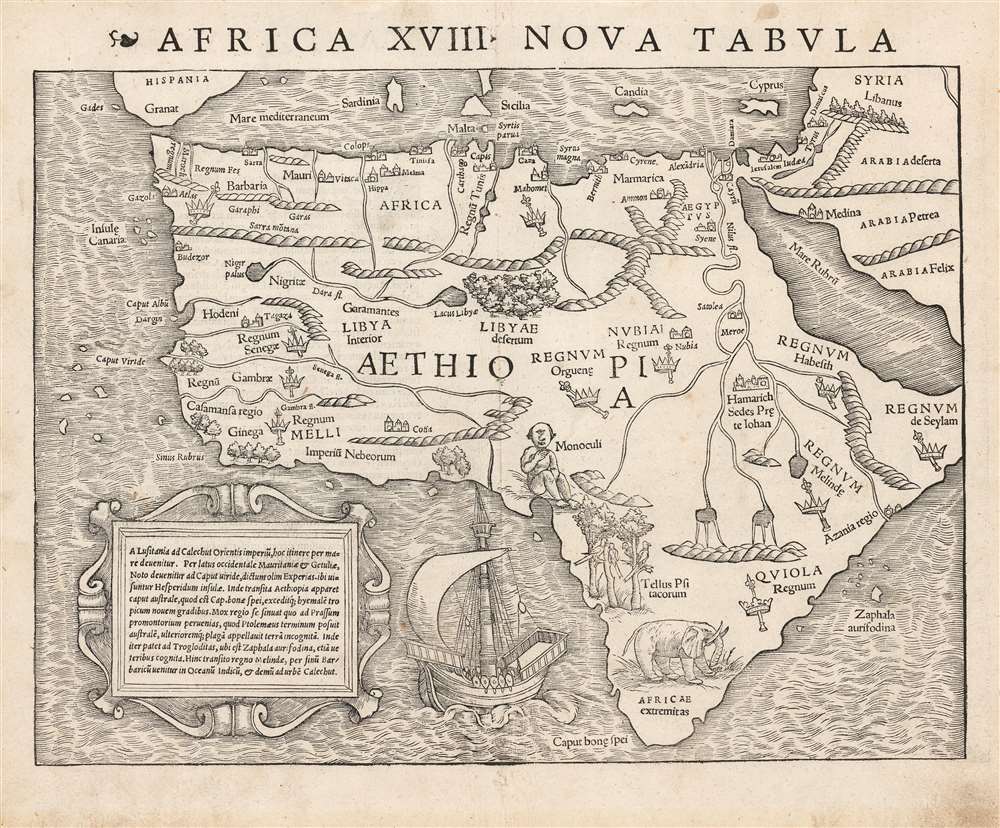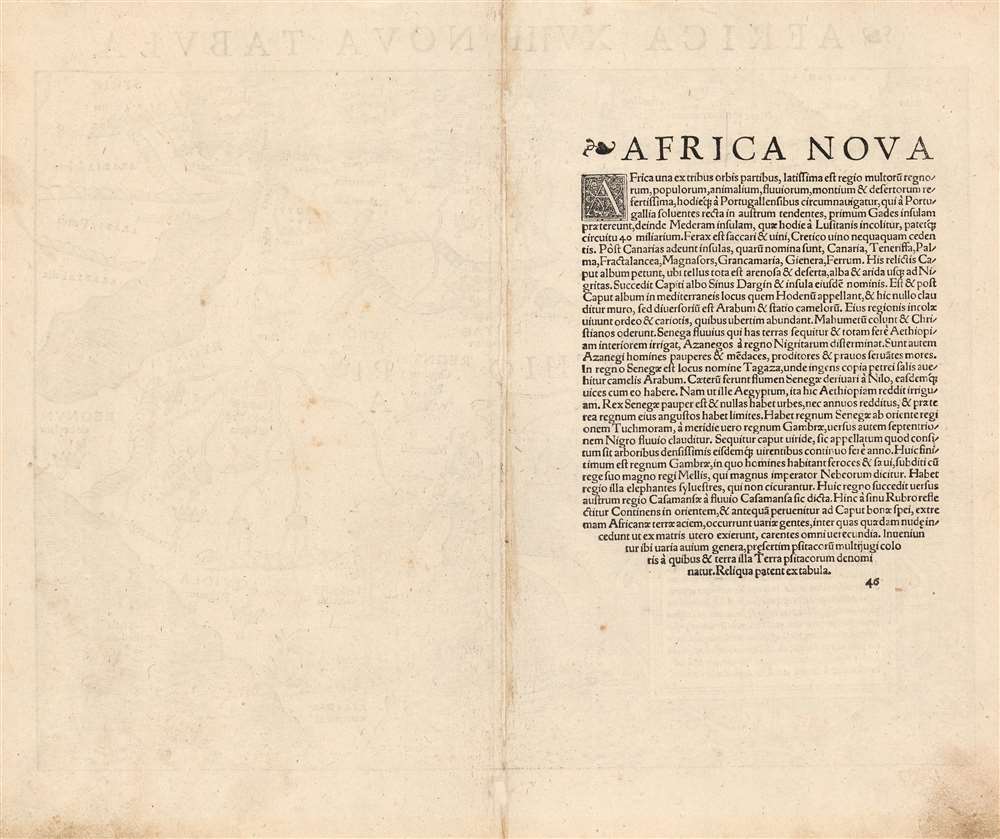
This item below is out of stock, but another example (left) is available. To view the available item, click "Details."
Details
1540 / 1552 Münster Map of Africa
$2,750.00
1540 Munster Map of Africa - FIRST EDITION / FIRST STATE!
Africa-munster-1540
Title
1540 (undated) 11.5 x 14.5 in (29.21 x 36.83 cm) 1 : 30000000
Description
The Map
Within its generally-recognizable depiction of the continent, this map presents an amalgam of sources. Most of the general detail of North Africa is derived from Ptolemaic geography, as is the course of the Nile with its sources in the lakes of the Mountains of the Moon (Ptolemy's assumptions about the sources of that river would remain unchallenged on maps of Africa until the end of the 17th century.) Many place names in North Africa were likely drawn from Leo Africanus' 1526 Descrittione dell 'Africa, though many - for example, Garamantes - are drawn from classical historians such as Herodotus. Münster draws on Portuguese sources for west Africa (Cadamosto's 15th century journeys there would reveal the Cape Verde Islands, which appear here.). Numerous kingdoms are noted throughout and are marked by a crown and scepter. Some of these include the Arab kingdoms of Melinde and Quiola, Meroë, where the Nubian kings are said to be buried, and Hamarich, the capital of the kingdom of the mythical Christian king Prester John.A Visually Compelling Map
Of the early maps of Africa, Münster's is the most entertaining, with its decorative elements such as parrots, an elephant, and a giant Cyclops. The grand ship shown sailing near the Cape of Good Hope does more than decorate: it reinforces the news that those waters were navigable, a reality not reflected in Ptolemy's mapping of the world until scholars began revising the 2nd century geographers' work at the end of the 15th century. By the time atlases such as Ortelius' began entering publication, Münster's groundbreaking map would be obsolete. One result of this is that despite its broad reach, the map was not copied by other mapmakers, making it visually unique - and an utterly essential map for the collector of maps of the discovery period in general, and Africa in particular.Publication History and Census
This map was printed for the first 1540 edition of Münster's Geographia. Only the 1540 and 1542 issues were titled 'Africa XVIII Nova Tabula.' The typesetting of the 1540 is unique: in the text box of the recto, the last two lines of text begin with 't' and 'b' respectively; this is not the case with the 1542. The verso text is also typeset differently: the second line of text on the 1540 ends 'regno/'; the slash is not present on the 1542. With further typographical changes, the map remained in each edition of Geographia, of which the 1552 was the last. The map was also included in all editions of Munster's Cosmographia until 1578, after which the double-page maps of the long-lived work were replaced and updated. While editions of Geographia are well represented in institutional collections, OCLC lists twenty seven copies dated 1540. The number of confirmed first editions, however, is likely to be lower, judging by the imprecision with which these institutional copies are catalogued. Only two examples of this 1540 state of the separate map are catalogued in OCLC, in the Bayerische Staatsbibliothek and the Universitatsbibliothek Eichstatt.CartographerS
Sebastian Münster (January 20, 1488 - May 26, 1552), was a German cartographer, cosmographer, Hebrew scholar and humanist. He was born at Ingelheim near Mainz, the son of Andreas Munster. He completed his studies at the Eberhard-Karls-Universität Tübingen in 1518, after which he was appointed to the University of Basel in 1527. As Professor of Hebrew, he edited the Hebrew Bible, accompanied by a Latin translation. In 1540 he published a Latin edition of Ptolemy's Geographia, which presented the ancient cartographer's 2nd century geographical data supplemented systematically with maps of the modern world. This was followed by what can be considered his principal work, the Cosmographia. First issued in 1544, this was the earliest German description of the modern world. It would become the go-to book for any literate layperson who wished to know about anywhere that was further than a day's journey from home. In preparation for his work on Cosmographia, Münster reached out to humanists around Europe and especially within the Holy Roman Empire, enlisting colleagues to provide him with up-to-date maps and views of their countries and cities, with the result that the book contains a disproportionate number of maps providing the first modern depictions of the areas they depict. Münster, as a religious man, was not producing a travel guide. Just as his work in ancient languages was intended to provide his students with as direct a connection as possible to scriptural revelation, his object in producing Cosmographia was to provide the reader with a description of all of creation: a further means of gaining revelation. The book, unsurprisingly, proved popular and was reissued in numerous editions and languages including Latin, French, Italian, and Czech. The last German edition was published in 1628, long after Münster's death of the plague in 1552. Cosmographia was one of the most successful and popular books of the 16th century, passing through 24 editions between 1544 and 1628. This success was due in part to its fascinating woodcuts (some by Hans Holbein the Younger, Urs Graf, Hans Rudolph Manuel Deutsch, and David Kandel). Münster's work was highly influential in reviving classical geography in 16th century Europe, and providing the intellectual foundations for the production of later compilations of cartographic work, such as Ortelius' Theatrum Orbis Terrarum Münster's output includes a small format 1536 map of Europe; the 1532 Grynaeus map of the world is also attributed to him. His non-geographical output includes Dictionarium trilingue in Latin, Greek, and Hebrew, and his 1537 Hebrew Gospel of Matthew. Most of Munster's work was published by his stepson, Heinrich Petri (Henricus Petrus), and his son Sebastian Henric Petri. More by this mapmaker...
Heinrich Petri (1508 - 1579) and his son Sebastian Henric Petri (1545 – 1627) were printers based in Basel, Switzerland. Heinrich was the son of the printer Adam Petri and Anna Selber. After Adam died in 1527, Anna married the humanist and geographer Sebastian Münster - one of Adam's collaborators. Sebastian contracted his stepson, Henricus Petri (Petrus), to print editions of his wildly popular Cosmographia. Later Petri, brought his son, Sebastian Henric Petri, into the family business. Their firm was known as the Officina Henricpetrina. In addition to the Cosmographia, they also published a number of other seminal works including the 1566 second edition of Nicolaus Copernicus's De Revolutionibus Orbium Coelestium and Georg Joachim Rheticus's Narratio. Learn More...




